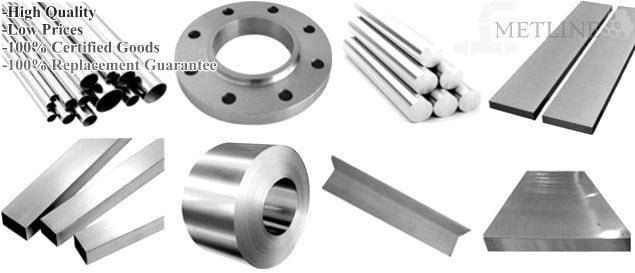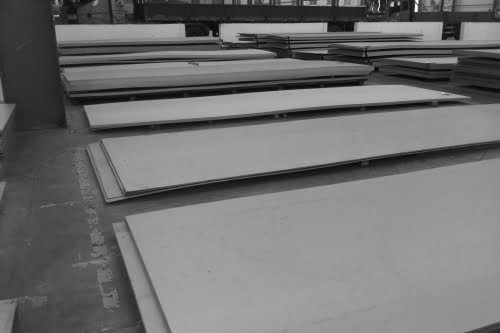In metallurgy, stainless steel, also known as inox steel or inox from French inoxydable (inoxidizable), is a steel alloy with a minimum of 10.5% chromium content by mass.
Stainless steel is notable for its corrosion resistance, and it is most widely used stainless steel alloy. For various different applications, different grades of stainless steels are used. These includes grades such as Stainless Steel 304, Stainless Steel 316 (316L the low carbon variant).
Stainless steel differs from carbon steel by the amount of chromium present. Unprotected carbon steel rusts readily when exposed to air and moisture. This iron oxide film (the rust) is active and accelerates corrosion by making it easier for more iron oxide to form. Since iron oxide has lower density than steel, the film expands and tends to flake and fall away. In comparison, stainless steels contain sufficient chromium to undergo passivation, forming an inert film of chromium oxide on the surface. This layer prevents further corrosion by blocking oxygen diffusion to the steel surface and stops corrosion from spreading into the bulk of the metal. Passivation occurs only if the proportion of chromium is high enough and oxygen is present in it.
Effects of Alloying Elements in Stainless Steel
Al Aluminum
produce a fine grain structure and to control grain growth. When added to molten steel, mixes very quickly with any
undissolved oxygen and is therefore considered one of the most common deoxidizers in making steel. Aluminum also is used to produce a fine grain structure and to control grain growth.
B Boron
Boron is added to steel in amounts of 0.0005 to 0.003% to improve hardenability. In combination with other alloying elements, boronacts as an “intensifier”, increasing the depth of hardening during quenching.
C Carbon
Produces the properties in steel that give it strength. As carbon content increases, there is a corresponding increase in tensile strength and hardness. Additionally, as carbon content increases, steel becomes increasingly responsive to heat treatment.
Cb Columbium
Columbium in 18-8 stainless steel has a similar effect to titanium in making the steel immune to harmful carbide precipitation and resultant inter-granular corrosion. Columbium bearing welding electrodes are used in welding both titanium and columbium bearing stainless steels since titanium would be lost in the weld arc, whereas columbium is carried over into the weld deposit.
Co Cobalt
Is used to increase the red hardness of a steel. It adds much life to a tool by its ability to maintain hardness and cutting ability when it’s heated to a dull red during a machining operation.
Cr Chromium
Like carbon, chromium helps the response to heat treatment. An increase in depth of hardness is also noticed with its use. When used in large quantities, it possesses a remarkable resistance to oxidation and corrosion. Used in conjunction with other alloys, chromium is one of the popular alloying elements.
Fe Iron
Although it lacks strength, iron is very soft and ductile, and does not respond to heat treatment to any degree. Iron is the primary element in steel. With the addition of other alloying elements, required mechanical properties can be achieved.
Mn Manganese
Is next to carbon in its importance in steel making. This is due primarily because of its ability to resist hot shortness or the tendency to tear while being forged or rolled. Manganese is used in almost every steel made, increasing responsiveness to heat treatment and acting as a deoxidizer.
Mo Molybdenum
Raises hot strength, has good creep resistance and helps steel resist softening at elevated temperatures. It is used to a large extent in tools and dies intended for hot working of metal.
Ni Nickel
Increases strength and toughness and has good fatigue resistance. Steels with nickel usually have more impact resistance than steels where nickel is absent. This is true especially at lower temperatures.
P Phosphorus
Is seldom deliberately added to steel but is carried as a residual or incidental element. When it is added it is usually for the purpose of machinability. Phosphorous is present in all steels and tends to increase resistance to corrosion while increasing yield strength.
Pb Lead
Is used in steel to improve machinability. In small amounts of .15 to .35% and finely divided and distributed, it has no known effect on the mechanical properties of steel.
S Sulfur
Is usually found in all steels and like phosphorus is considered a residual element. When added purposely it substantially increases machinability. The amount for this purpose is usually from .06 to .30%. Sulfur is considered the basic element for free machining steels. It is,however, detrimental to the hot forming properties.
Si Silicon
Is the most common deoxidizing agent. In amounts up to 1% it has a marked strengthening and toughening effect. In higher amounts it produces electrical resistance and gives high magnetic permeability.
Ti Titanium
Titanium is added to 18-8 stainless steels to make them immune harmful carbide precipitation. It is sometimes added to low carbon sheets to make them more suitable for porcelain enameling.
W Tungsten
Promoted red hardness and hot strength in addition to producing dense grain and a keen cutting edge. These properties make tungsten steels very useful for hot working applications such as cutting tools when the steel is hot enough to be low red in color.
V Vanadium
Is a strong deoxidizer and promotes fine grain structure. It helps steel resist softening at elevated temperatures and seems to resist shock better than steels without it.
Metline Industries is a leading stockholder and processor of stainless steel alloys in various forms including pipes, plates, fittings, flanges. We are ISO certified company, with exports to over 50 countries worldwide. Our key products include stainless steel plates, stainless steel sheets, stainless steel pipes, stainless steel pipe fittings, stainless steel bars and stainless steel flanges.







Leave A Comment